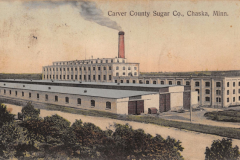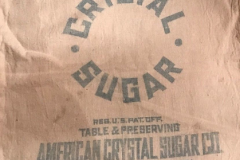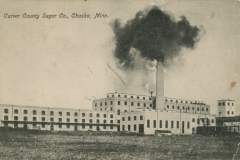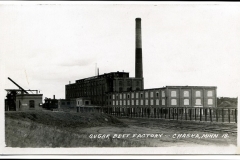Shake hands, ye one and all of the good and prosperous and energetic city of Chaska, for now the Sugar Factory question is settled and Chaska is the point blessed by its selection(.) At a meeting this forenoon the question was definitely settled once and forever and the suspense is over, and now lets all get busy and shake hands and join in the frolic. It means to us more than anything has ever meant since the sturdy fore fathers of our first staked their hearts and fortunes on the site where we live to-day, the little progressive Minnesota Valley city which has been so fortunate by the grace of its natural location, the greatness and adaptability of its soil and the good and true qualities and eye for the beautiful of the men behind the gun, Messrs Churchill, Warren and the not-to-be forgotten site man, Mr. Wallace. They knew a good thing when they saw it and hence “Chaska, The Sugar Center of the Northwest.” Our pretty little city of Chaska, the county seat of Carver county, has 2200 population, and in natural beauty and advantage cannot be surpassed in this state or any other. Its selection as the lpace (place) for the immense sugar industry was a wise one and after it is once established the promoters will realize this feature. Chaska has many notable industries, among them the Ess Bros., Foundry, Wagon and Sleigh Factory; The Gedney Pickling Works; The Chaska Canning actory (factory); The Chaska Flouring Mills; The Fink Bros. Bung Factory; Three large and important brick yards; The Geiser Factory; and two newspapers, besides many other large business establishments, and we are happy to say all are doing an excellent business. The total investment in this plant when complete will be about $500,000. There will be two (2) million brick in the buildings, and also two and a half miles of R. R. tracks about the grounds. The main building will be three stories high. A sugar factory commences operation about Nov. 1st and continues for 120 days and 185 men are employed outside of the office force. Work will be commenced on the foundation within two weeks. Mr. J. A. Shephard, the engineer from Toledo, Ohio, with his builder is on the ground making his surveys. (Weekly Valley Herald, Thursday, October 19, 1905, Page 1)
A Hint to our Business Men. What a grand thing it would be if Chaska would raise $50,000 bonus for a large sugar beet Factory. We think stock would be taken by our farmers, business men and others to an equal amount. A factory of this kind would employ several hundred men during the fall and winter, and besides bring more business to Chaska than any other enterprise we could secure. We have the best belt of country in the north west for Beet raising, and a large population who have had experience in Germany in Beet culture for sugar making. We are ready to second any move that can or will be made, to secure a plant of this kind for Chaska. Who will set the ball rolling? (Weekly Valley Herald, Thursday, June 16, 1892, Page 4)
At the present time it would do well for the citizens of Chaska to turn their attention toward getting the Minnesota Sugar Co., whose plant at St. Louis Park, was recently destroyed by fire to locate here. (Weekly Valley Herald, Thursday, May 18, 1905, Page 1)
The Carver County Sugar Company’s plant will be a 600 ton house, built on a site that you can’t duplicate in the country and will consist of six buildings, namely: The main building enclosing the offices, machinery, etc., will be 68 feet by 160, and will be 4 stories high, with monitor, and will be built of Chaska brick. The warehouse will be 68 by 200 feet, and will be 3 stories high. The beet house will be 400 feet by 130 feet, and will be one story high. The cooper shops will be 40 by 80 feet, one story. The boiler house will be 58 feet by 168, 2 stories high. The lime house will be 48 feet by 73 feet, and will be 2 stories, with 3 story monitor. The plant will be twice as large as the one destroyed by fire at St. Louis Park, and if enough beets are raised to run the factory at full capacity it will be able to turn out between 15,000,000 and 16,000,000 pounds of the best granulated sugar on earth. The buildings will be all of the best construction, steele (steel) frame and absolutely fireproof. The sugar manufacturing season generally starts about the 15th day of October and lasts about 100 days. The force employed by the Carver County Sugar Company will be between 200 and 250 men. The value of the buildings and machinery is estimated at $700,000. The plant will be lighted by electricity, and will have its own power plant. (Weekly Valley Herald, Thursday, December 21, 1905, Page 1)
The immense brick smoke stack is rapidly nearing completion, and the foundation for the office buildings are already laid and will be hustled along in good shape. The structure will be built of Chaska brick, and will be model and convenient in all its appointments. The steel structural work for all the buildings comprising the plant is progressing satisfactorily, and in a month or two, will be encased, and the stranger can see for himself what the complete plant will look like. (Weekly Valley Herald, Thursday, April 26, 1906, Page 1)
The Carver county sugar factory, the only one in the state having the capacity of 600,000 tons, began operations today. The machinery was set in motion on Saturday and everything proved satisfactory. With this plant in operation, Chaska will not only be a brick city, but a sugar city as well. (The Minneapolis Journal, Tuesday Evening, October 16, 1906, Page 4)
This Thursday morning, Oct. 17, 1906, marks the opening day of the Carver County Sugar factory in this city. The Buildings. The buildings comprising the Carver Co., Sugar factory are mammoth in proportion and comprise, six big buildings, namely: The main building enclosing the sugar manufacturing machinery is 68×160, 4 stories high with monitor, and is built of Chaska brick. It is a handsome and substantial structure, and a credit to any city in the United States. The great long beet sheds are 400 feet long and 130 feet wide, one story high, and the capacity of the buildings is 15,000 tons of sugar beets. The warehouse with all its modern conveniences is 3 stories high, and the dimensions of the same is 68×200 feet. Great numbers of barrels are now stored within soon to be filled with the choicest granulated sugar the world can produce. The lime stone house is 48×73 feet, 2 stories high, and contains the lime stone used for purifying purposes. Most of the lime used by the Carver County Sugar factory comes from Faribault. The boiler house is 58×168, 2 stories high, and is a model and complete one in every respect. The value of the buildings and the machinery is estimated at about $700,000. All are built of brick, steel frame and are absolutely fire-proof. (Weekly Valley Herald, Thursday, October 18, 1906, Page 1)



